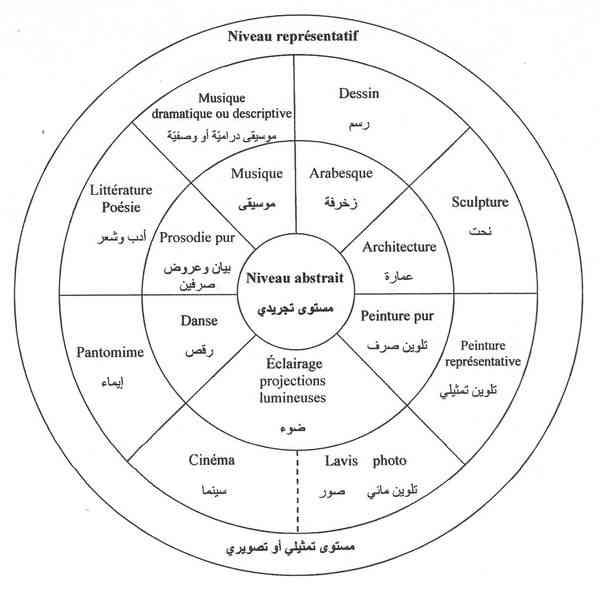After the emergence of many classifications of arts developed by philosophers such as "Moris Nidonsel", "Alin" or "Schelling" "Etienne Souriau" presented us with his vision for the classification of the arts divided into seven with two degrees each. Graphic / abstract, and the seven arts are of two grades each:

Sculpture / architecture - drawing / decoration - representative coloring / pure coloring - expressive or descriptive music / music - gesture / dance - literature and poetry / statement and exchange offers - cinema / lighting
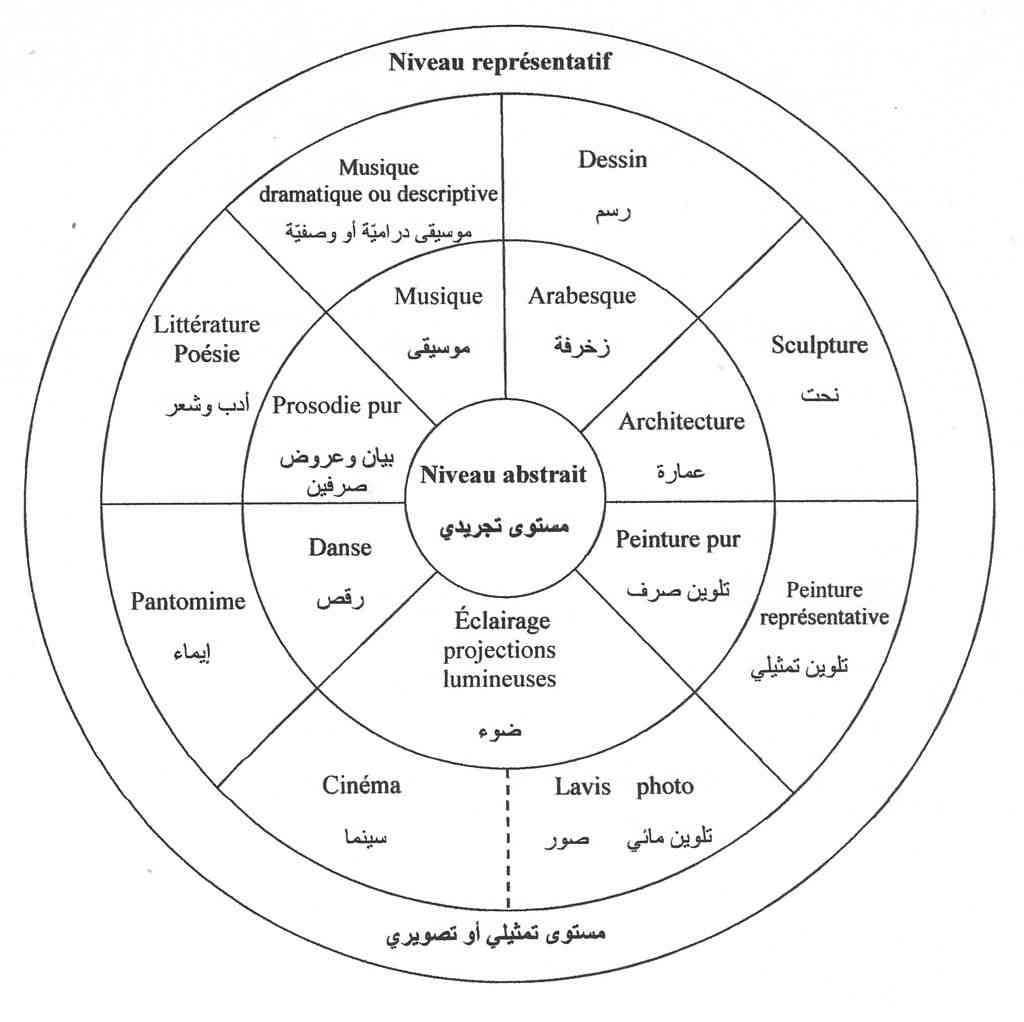

Etienne Suryo's analysis of these seven arts shows his conception of the general schedule of the fine arts system (corresponding figure) in the following way:
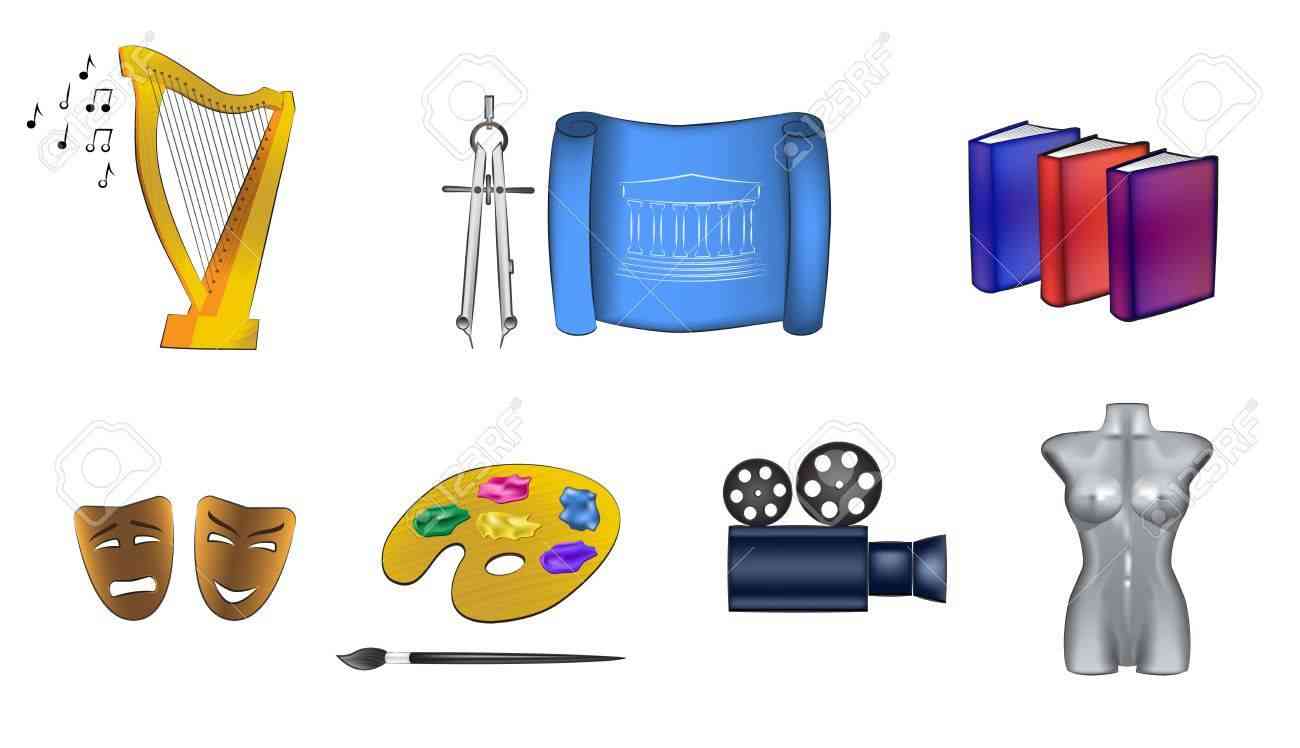
<< Every sensory special, or rather every gradual set of sensory properties that can be used technically (line, color, bump, illumination, movement, pronunciation, pure tone), creates two artists, one of which is of the first degree (non-graphic arts) and the other of the second degree (graphic arts) . It suffices to register on the periphery of the circle of all the first-class arts composed of the seven sensory groups and to register on the periphery of a concentric external circle and in the same fields as the second-degree arts that correspond to them, so we get a general table of all the relationships that compose organically the fine arts system >>
Attempts to collect art:
Art history can be separated into two phases, depending on the invention of cinema, as an event that added a seventh art to the arts and transformed the place of its cooperation and collection from theater to cinema. This is confirmed by Dr. Okasha Tharwat: [However, all the arts tend to unite together, and often converge to complement each other. Since the Greek era, the artists' efforts are endless in order to create a comprehensive artwork that brings together all the arts. This work was embodied first in Greek drama, which combined poetry, singing, music and gestural dance against a backdrop of scenes drawn by plastic artists ... All the arts converged in both opera and ballet models, but they did not reach the level of wonderful balance and integration ...
At the beginning, the cinema was nothing but silent visual art, which displayed animated images that did not sound like "Paula Negri", "Rudolf Valentino" and "Charlie Chaplin" in his early days. Even if you discover "salinium"That converts sound waves into light waves and then converts these to sound. The cinema began its enormous step in collecting visual and audio arts, and took the progress of theater, music and plastic arts all in one wonderful work of harmony, and cinema became a means to achieve the perfection of all arts, as it shattered the barriers of time and The place carries the finest works of art among the world over what ballet and opera can neither.
Attempts to collect art (((BEFORE))) the birth of the seventh art (cinema):
Throughout history there have been many attempts to collect a number of arts in a single artwork - spontaneously or intentionally - due to the strength of its combined effect on the senses of the recipient who communicates with the artwork with its various senses. But a few of these attempts to bring together most of the arts, including:
Religious rituals in the temples of ancient civilizations: As these rituals were held in the temple decorated with colorful drawings and decorations in addition to the costumes of the participants in the exhibition and decorated with various drawings and colors with the presence of some statues of deities within these rituals sometimes, and the performers in this presentation recite poems or dialogue with gestural movements She is a certain dancer and may be accompanied by music or rhythms of tambourines.
Greek theater: where the sculpture appears in the theater and decoration architecture as well as in the masks and costumes of the actors, as drawing and coloring appears in the paintings of the scenes drawn within the decoration, poetry appears in the dialogue and the poems recited, the music appears in the melodies of songs and playing some instruments and the dance appears in the representation of the actors (gesture and dance) Choir).
Ecclesiastical rituals: Ecclesiastical rituals are held within the plastic atmosphere found in churches, whether Byzantine (oriental) or western ones, and it is worth mentioning that these rituals have evolved into ritual drama and semi-ritual drama and then to the praises of Oratorio finally to the opera..)
The opera: where the cooperation of the arts is evident in terms of architecture, decoration, fashion, masks, backgrounds, and text sung by gestures or dancing on the melodies of music.
The Mevlevi councils in mosques and mystical corners: The cooperation of the arts appears by linking the place and the event, where we find sculptures in architecture and muqarnas, as well as colorful decorations in mosques and mystic corners, where the Mevlevi council, which includes poetry, music, and dance, is established with a close association of symbols, shapes, movements and sound.
Attempts to collect the seven arts (((AFTER))) the birth of the seventh art (cinema):
After the birth of the cinema and its development into a colorful speaker, it turned into a crucible for collecting arts, whether in the representative films or in the films of cartoons and animations, and we have many examples where a collection of the seven arts appeared together, including:
1."The Wall", directed by Alan PARKER and produced by Metro Goldwyn Mayer, with Pink Floyd and Gerald SCARF, in 1982.
2.Animated films that combine 3D and 2D + 3D technologies such as "TITAN: A-E", "A Bug's Life" and "SHREK" series.
The cooperation of the arts in cinematic works has contributed to the development of the plastic arts, and this is confirmed by Dr. Afif Al-Bahnasi: [The camera has presented scenes and images whose creative value cannot be ignored, and although schools such as cubism and abstraction have found followers in the field of cinema, the filmmakers did not stop.
At the borders of these schools, their methods have helped them transcend the data of modern art, and at least we can say that the synergy of arts in cinematic work has given way to the emergence of cinematic trends independent of the plastic arts Rather, it became a pioneer of these trends, and thus we began to see photography and sculptures resorting to cinema under the slogan "L'art cinetique" or under the slogan of "visual art". (...) And the near future may eliminate the differences between cinema and plastic arts and make plastic art at the core of cinema. It also makes cinematography one of the most advanced plastic arts.]
On the other hand, after the development of parallel video techniques for cinema techniques, artistic attempts have emerged to collect the seven arts in some of the works of the terminology “video art” in contemporary art: we find drawings and sculpted and colored motifs that move with music, poetry or dialogue within a work of art “video art”. "
Motivation to collect the seven arts:
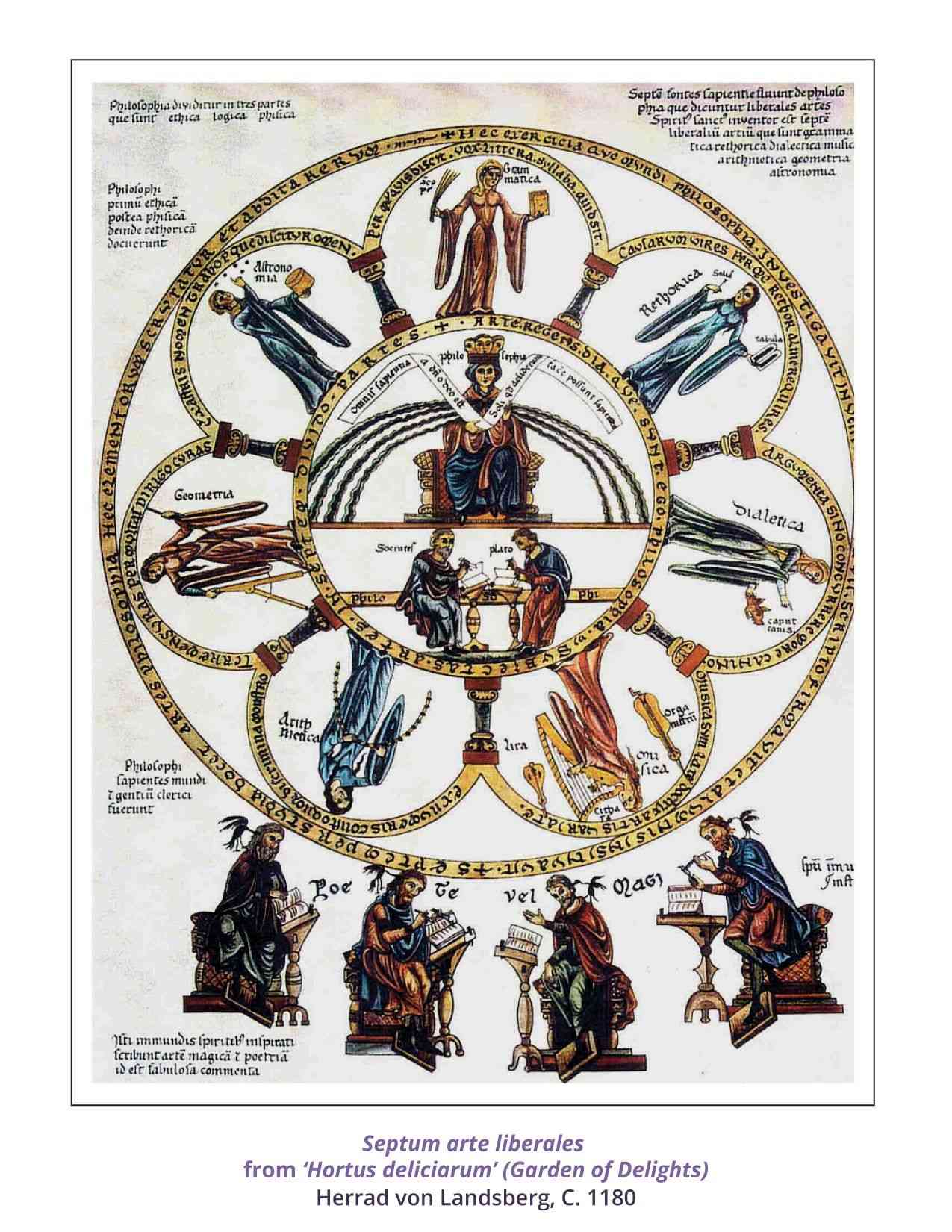
After reviewing the aspects of collecting the seven arts through the most important historical stages, we still have a question about the motive for collecting art. What is the instigator, guide, or motivation for artists and the artistic path that moves them towards collecting arts?
To try to answer this question, we will present some of the critics ’views on this issue: In the opinion of“ Dr. Asaad Orabi ”, the reason lies in the fact that the source of the arts is one. Writer: [I liked these repercussions to refer to the systems of nature in the unity of audiovisual arts, as the monotheistic reference is the controls of the universe and its “shaggy” physics in the contemporary sense.
In the opinion of "Dr. Paul Raman", the collection of arts generates special feelings, which may be the motive for the artists' pursuit of the cooperation of the arts: [There is no law in the science of life and in the science of functions that prevents similar hearts generated from our hearts from being opened in the depths of our souls. A matter of sensory harmony]
As for the opinion of “Dr. Afif Al-Bahnasi”, the motivation is the human’s attempt to create a new beauty added to the complex beauty of nature, as this appears in what he wrote: [The unity between the arts is essential, meaning that art, whether formal or phonetic, is issued by an attempt to create a new beauty Added to the beauty of nature, which has a complexity of form, movement and sound as well.
However, the conditions of growth and specialization were separated among the elements of this unit, which prompted the artists to reassemble these elements in a complex artwork of kinetic, acoustic, formal and light arts such as theater and cinema. Rather, the artist in it tries to act together as a director, photographer, composer, and ornate artist in order to achieve a solid unity in building his artwork. Likewise, as the architect, he has moved towards complete domination of all elements of his work, as he decides design, color, motifs, paintings and innovative materials, also seeking unity of artistic work.]
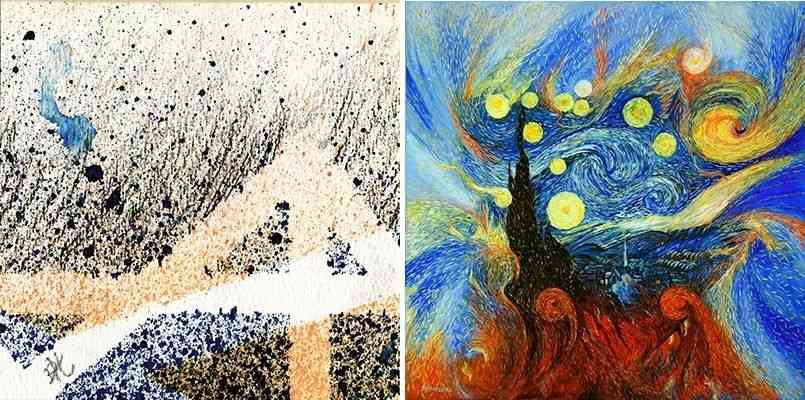
Thank You For Reading The Article, I Hope You Enjoyed, Subscribe To Our Author's Page,,, Thanks.
-EnRi

